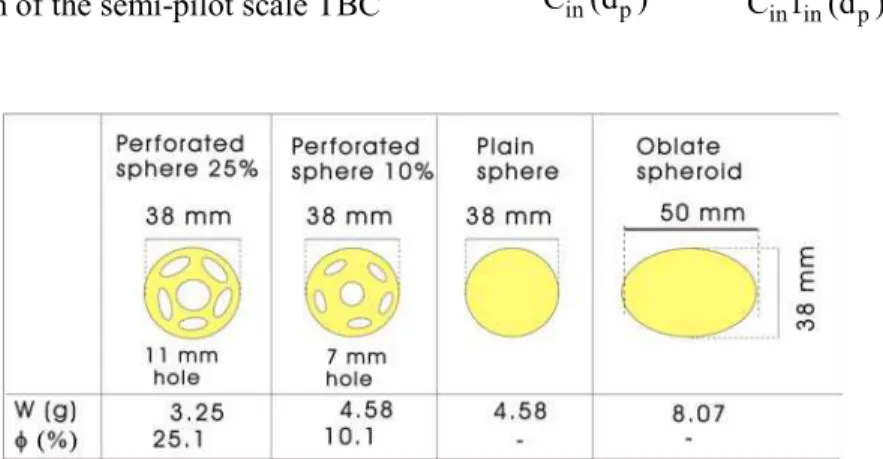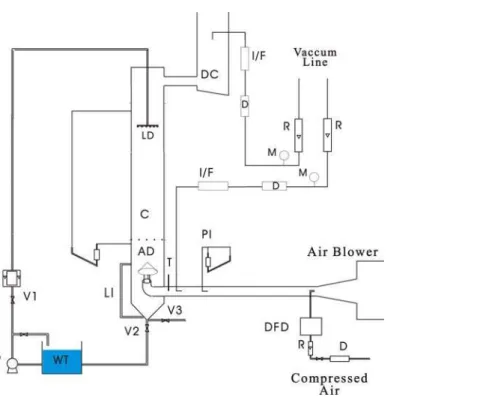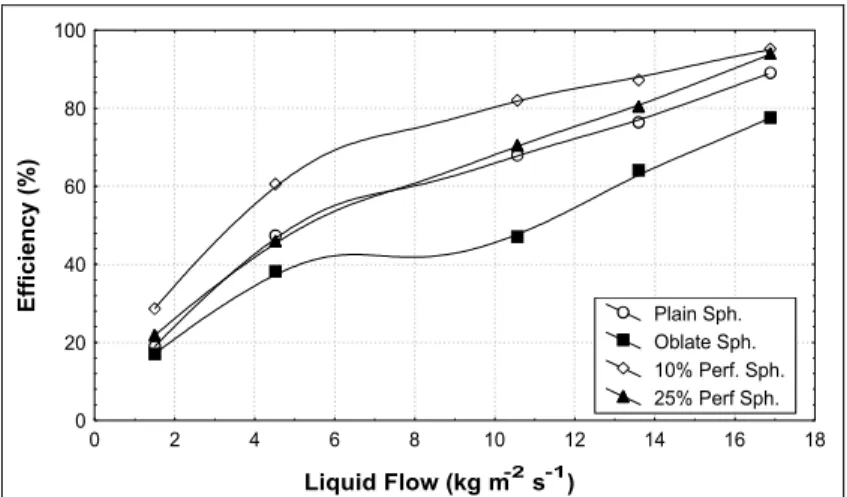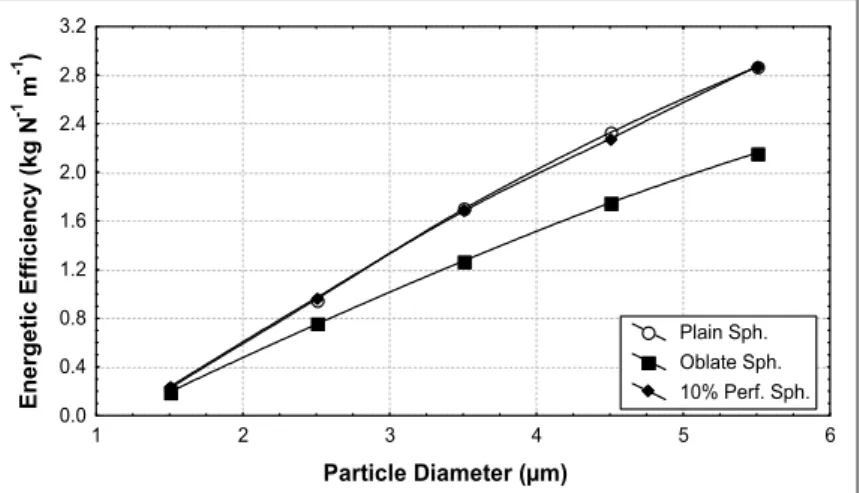ISSN 0104-6632 Printed in Brazil
www.abeq.org.br/bjche
Vol. 24, No. 01, pp. 37 - 45, January - March, 2007
Brazilian Journal
of Chemical
Engineering
A TURBULENT BED CONTACTOR: ENERGETIC
EFFICIENCY FOR PARTICLE COLLECTION
M. L. Gimenes
1, D. Handley
2and M. G. C. Silva
3*1
Department of Chemical Engineering, State University of Maringá - PR, Brazil. E-mail: marcelino@deq.uem.br
2
The University of Leeds, Leeds, England.
3
School of Chemical Engineering, State University of Campinas, P.O. Box 6066, Zip Code 13083-970, Campinas, SP, Brazil.
E-mail: meuris@feq.unicamp.br
(Received: October 04, 2005 ; Accepted: August 25, 2006)
Abstract - Particle collection experiments were conducted in a fluidizing irrigated bed to evaluate the
performance of mobile packings: 38 × 50 mm plain oblate spheroids 38 mm ID plain spheres and alternative perforated spheres with a 38 mm ID and 10% and 25% free areas were used as fluidizing media in a 0.264 m diameter and 1.20 m high turbulent bed contactor (TBC). Particle collection experiments were carried out above the minimum fluidization velocity, using as particulate test powder polysized alumina (size 1.5 to 5.5 µm). Experimental results demonstrated that the perforated spheres performed better in collecting particles than the other packings tested. The efficiency of particle collection was analysed based on energy consumption in the TBC, using the energetic efficiency concept. It was verified that not much more energy was consumed per unit of gas flow in fluidized beds of perforated packings than in those of conventional plain sphere packings, since the perforated spheres were more energetically efficient for particle collection than plain spheres and oblate spheroid packings.
Keywords: Energetic efficiency; Mobile packings; Turbulent bed contactor.
INTRODUCTION
The turbulent bed contactor (TBC) is a fluidised bed of low-density packings that fluidises between a lower and an upper retaining grid. Under fluidization conditions the upward flow of the gas in a downward flowing liquid stream produces a turbulent random motion of the packings that intensifies contact between the gas and the liquid phases, thus providing high interfacial transfer rates.
As a contactor this equipment can be used in several operations requiring gas-liquid contacting. Industrial interest in this technique has developed, resulting in applications in operations involving direct contact heat transfer, gas absorption, dehumidification and wet scrubbing for particle removal.
Utilisation of TBC in operations to clean gases offers the advantage of simultaneous removal of particulate and gaseous pollutants with a relatively small pressure drop. The fundamental advantage over other wet scrubbers is their self-cleaning feature when used with gases or liquid containing particulate material. In the fluidised bed, packings are continuously cleaned by tumbling against one another, thus preventing particulate build-up in the packing, and resulting in the non-clogging feature of the equipment.
TBCs. This type of packing was specially designed for retaining more liquid in the bed during the fluidization process, as described by Gimenes (1992).
A comparison of the performance of these packings clearly demonstrates that perforated spheres are more efficient in collecting particles than the plain conventional packings (Gimenes and Handley, 1998). However, this high efficiency in removing particles from gas streams is due to the ability of these packings to retain a high hold-up of liquid in the bed. The hold-up of liquid is maintained in the fluidised bed at the expense of energy, which is reflected by a pressure drop throughout the bed. Therefore the definition of particle collection efficiency alone may not be satisfactory to compare packings when energy consumption is considered. This paper presents the concept of energetic efficiency, which is used to compare the performance of the new perforated spheres in collecting particles with plain sphere and oblate spheroid packings.
MATERIALS AND METHODS
Figure 1 illustrates the dimensions and characteristics of polypropylene packing types used as fluidising media in the TBC for particle collection experiments. Perforated spheres were made of 12 equally spaced holes on a plain sphere surface. This uniform distribution of perforations results in a triangular pitch arrangement. In order to maintain the weight of the perforated sphere with a 10% free area the same as that of plain spheres, the former were inserted with a cylindrical rod. This was done not only to balance out the weight loss, but also to clean internal surfaces of the packing in the case of particle encrustation.
In Figure 2 a diagram of the semi-pilot scale TBC
and the facilities used to carry out experiments are shown. The fluidising column was made of perspex (1.20 m high and 0.264 m ID) and its grid for retaining fluidising packings had an 84% free area.
An air blower was used to fluidise the number and weight of packings presented in Table 1. The liquid used was tap water, which was distributed evenly over the packings and recycled into the system. Hydrodynamic experiments were first carried out in the fluidised bed for the set of static bed heights in Table 1. In these experiments bed pressure drop, liquid hold-up and bed height expansion were measured for gas velocities and liquid flow rates in the range of 0.2 to 4.0 m/s and 1.5 to 16.9 kg/(m2 s), respectively.
Particle collection experiments were carried out for the same range of liquid flow rates as that used in the set of hydrodynamics experiments, but for gas velocities above the respective minimum fluidization velocity. In these experiments alumina (Al2O3) with
a 1.5 to 5.5 µm aerodynamic diameter was used as the particulate material to be collected in the fluidised bed. The powder had been previously dried and it was dispersed into the air stream using a dust feed disperser (Gimenes and Handley, 1999). A set of probes was used to sample the dispersed particles simultaneously on two identical Pilat Mark III cascade impactors, which were installed at the TBC inlet and outlet. Procedures to sample particles and to process the acquired data to obtain the distribution size of particles were carried in accordance with Pilat (1979). The efficiency of particle collection (η) or particle penetration (Pt) for each particle size (dp)
was calculated according to equation (1):
p p
T
out p out out p
T
in p in in p
(d ) 1 Pt(d )
C (d ) C f (d )
1 1
C (d ) C f (d )
η = − =
= − = −
(1)
LEGEND
AD - Air Distributor C - Column D - Drying Column DC - Droplet Collector DFD - Dust Feed Dispersor I/F - Impactor/Filter G - Grid
LI - Liquid Distributor
M - Manometer (Vaccum)
P - Pump
PI - Pitot Tube
R - Rotameter
T - Thermometer
V1, V2, V3 - Valves
WT - Water Tank
Figure 2: Experimental rig used to test turbulent bed contactor packings
Table 1: NP – Number of packings and WB – weight of dry bed in kg
Static bed height → H0 = 0.135 m H0 = 0.250 m H0 = 0.380 m
Packings ↓ NP WB NP WB NP WB
Plain Spheres 140 0.641 280 1.282 420 1.923
Perf. Spheres 10% 140 0.641 280 1.282 420 1.923
Perf. Spheres 25% 140 0.455 280 0.910 420 1.365
Oblate Spheroids 80 0.645 160 1.291 240 1.936
RESULTS AND DISCUSSION
A comparative study of the packings in Figure 2 has already been presented in the literature (Gimenes and Handley, 1999). An illustration of this is presented in Figures 3 and 4, which show the performance of packings in collecting alumina powder. The results clearly demonstrate that perforated spheres with a 10% free area have higher efficiency values than the other packings studied, thus being the most efficient type of packing investigated. The lowest efficiency of particle collection was observed for the oblate spheroid packing type. The high efficiency of
perforated packings was attributed to the high hold-up of liquid in the bed and lower intensity of bed height fluctuation during fluidization (Gimenes, 1992).
Liquid Flow (kg m-2 s-1)
Ef
fi
cien
cy (
%
)
0 20 40 60 80 100
0 2 4 6 8 10 12 14 16 18
Plain Sph. Oblate Sph. 10% Perf. Sph. 25% Perf Sph.
Figure 3: Efficiency of particle collection versus liquid mass velocity (H0 = 0.25 m, UG = 3.5 m/s, dp = 4.5 µm)
Particle Diameter (µm)
Ef
fi
cien
cy (
%
)
0 20 40 60 80 100
1 2 3 4 5 6
Plain Sph. Oblate Sph. 10% Perf. Sph. 25% Perf Sph.
Figure 4: Efficiency of particle collection versus particle diameter (H0 = 0.25 m, L = 16.9 kg/(m
2
s), UG = 3.5 m/s)
Superficial Gas Velocity (m s-1)
P
ressure D
rop (cm
H
2
O)
0 1 2 3 4 5 6 7 8 9
0.0 0.5 1.0 1.5 2.0 2.5 3.0 3.5 4.0 4.5 Plain Sph. Oblate Sph. 10% Perf. Sph. 25% Perf Sph.
Figure 5: Bed pressure drop versus superficial gas
Considering the importance of comparing the performance of packings based on the energy consumed, the establishment of a measure for energy utilisation efficiency is required. Energetic efficiency, a concept that relates the usual efficiency of separation to the power consumption required to achieve that separation, was proposed by Huynh et al. (1991) for molecular mass transfer in a Venturi/bubble column combination. These authors defined energy-based efficiency as the amount of material transferred per unit of energy consumed. A similar concept, which also involves the energy consumed, can be used for particle collection in a TBC by a comprehensive analysis of energy consumption.
Energy consumption in the TBC includes the potential and kinetic energy of the gas and liquid and the energy related to gas and liquid pressures. By neglecting the energy consumption related to the potential energy of the gas and the kinetic energy of the liquid, the following equation expresses the rate at which energy is consumed per unit of area in a TBC:
PRG PRL PTL
E=E +E +E (2)
where EPRG and EPRL are the rates of energy
consumption related to pressure for the gas and liquid respectively and EPTL is the consumption
related to the potential energy of the liquid. In other words, EPRL and EPTL represent the energy required to
pump the liquid at the top of the bed. EPRG is related
to the pressure drop in the gas as it passes through the fluidized bed. If the volume flow rate of the liquid is not much higher than the gas flow rate and the height to which the liquid has to be elevated is rather low (as is the case of a TBC), EPRL and EPTL
can be neglected. Therefore the rate of energy consumption per unit of area of the TBC is related to EPRG:
in
PRG g
g out
dP
E=E =W
ρ
∫
(3)Equation (3) is not only an approximation, but is totally true for the case of comparisons for the same volume of liquid flow. Considering that the pressure of the gas in the TBC does not change by more than 20%, it is usually satisfactory to treat the gas as
incompressible fluid with a density equal to that at mean pressure (Coulson and Richardson, 1990). The rate of energy consumption per unit of cross-sectional area of the TBC becomes
*
PRG g
E = ∆P.U (3.a)
The energetic efficiency of particle collection (ηe)
can be defined as the ratio of the rate of particle collection per unit of area (R) to the respective rate of energy consumed per unit of area of the TBC.
e
g R PU η =
∆ (4)
The rate of particle collection per unit of area (R) can be described as
g
R=m U C (5)
where Ug is the superficial gas velocity, H is the
expanded bed height of the fluidised bed, C is the particle concentration and m is the overall coefficient of particle transfer.
In an attempt to obtain a model to predict particle collection in TBC the overall coefficient m was determined experimentally only for plain spheres by Uysal (1979). A more comprehensive model, including the packings described in Figure 1, was proposed by Gimenes and Handley (1998) to predict particle penetration (Pt) in TBC based on the overall particle transfer coefficient m.
(
)
Pt=exp −mH (6)
In this model the m coefficient was obtained from the fit of experimental data on particle collection in the TBC, considering the simultaneous action of inertial impaction, interception and turbulent diffusion as mechanisms of particle collection by the liquid in the bed. This coefficient m was expressed as a function of dimensionless numbers that characterize these mechanisms of particle collection, the bed hydrodynamics and the structure of the bed and type of packings.
o MLH L
g L
pack pack g
H (1 ) w
m f (St, Re , Re , , , )
d w
− φ ε
=
Substituting the m coefficient from the model equation (6) into equation (5) results in the following expression for the rate of particle collection R
g 1
R U C ln
Pt
= (8)
The rate of particle collection shown in equation (8) is dependent on the mechanisms of particle collection and bed hydrodynamics. It also takes into account the structure of the bed and specially the type of packings used in the TBC. Substitution of this equation into equation (4) allows the energetic efficiency of particle collection (ηe) to be obtained
e
1 C ln
Pt P
η =
∆ (9)
The energetic efficiency was calculated with equation (9) from experimental data on particle penetration obtained for the packing types in Figure 1, using several concentrations of alumina particles. This data was obtained using different static bed heights and wide ranges of liquid and gas flow-rates, which in turn produced different pressure drops in the bed. The results of energetic efficiency calculated for the packing types are presented in Figures 6 to 9.
Particle Diameter (µm)
En
erg
e
ti
c Effi
ci
en
cy (kg
N
-1 m -1 )
0.0 0.4 0.8 1.2 1.6 2.0 2.4 2.8 3.2
1 2 3 4 5 6
Plain Sph. Oblate Sph. 10% Perf. Sph.
Figure 6: Energetic efficiency vs particle diameter for H0 = 0.135m, UG = 2.5 m/s, L = 10.58 kg/(m
2
s)
Particle Diameter (µm)
En
erg
e
tic Ef
ficien
cy (
k
g
N
-1 m -1 )
0 1 2 3 4
1 2 3 4 5 6
Plain Sph. Oblate Sph. 10% Perf. Sph. 25% Perf Sph.
Figure 7: Energetic efficiency vs particle diameter for H0 = 0.38m, UG = 2.5 m/s, L = 10.58 kg/(m
2
Particle Diameter (µm)
En
erg
e
tic Ef
ficien
cy (
k
g
N
-1 m -1 )
0 1 2 3 4 5 6
1 2 3 4 5 6
Plain Sph. Oblate Sph. 10% Perf. Sph. 25% Perf Sph.
Figure 8: Energetic efficiency vs particle diameter for H0 = 0.25m, UG = 3.5 m/s, L = 16.94 kg/(m
2
s)
Particle Diameter (µm)
En
erg
e
ti
c Ef
fi
cien
cy (
k
g
N
-1 m -1 )
0.0 0.2 0.4 0.6 0.8 1.0 1.2 1.4
1 2 3 4 5 6
Plain Sph. Oblate Sph. 10% Perf. Sph. 25% Perf Sph.
Figure 9: Energetic efficiency vs particle diameter for H0 = 0.25m, UG = 3.5 m/s, L = 1.51 kg/(m
2
s)
The effect of particle size on energetic efficiency is evident in all results presented in Figures 6 to 9. These figures clearly illustrate that as the size of alumina particles increases much less energy is required to collect them, mainly as a result of the action of inertial impaction and in some instances interception. Results presented in these figures reveal that the oblate spheroid is the least energetic efficient type of packing investigated.
With a small number of packings, i.e. in short beds, there is no difference between the energetic efficiency of plain sphere and that of perforated sphere packings, as demonstrated by the data in Figure 6. A comparison of data presented in Figures 6 and 7 allows the observation that beds with higher
static bed heights have a higher energetic efficiency. In both figures it is possible to observe that packings of perforated spheres (10%) are the most highly energetic efficient.
energetic efficiency according to equation (9). At this high liquid flow rate it seems likely that the liquid hold-up in the 10% perforated packings is not completely extended, providing an interfacial area to collect particles as in the 25% perforated packings. In the case of a high liquid flow rate, the greater liquid hold-up does not appear to be very effective in increasing the rate of particle collection. The corresponding increase in energy consumption is relatively more pronounced, thus decreasing the energetic efficiency.
At extremely low liquid flow rates, as in the results presented in Figure 9, the energetic efficiencies are quite a bit smaller than those at the high liquid flow rates. Under this condition perforated spheres have a better performance than plain sphere packings.
CONCLUSIONS
In this paper an index called the energetic efficiency of particle collection is defined as the ratio of the rate of particle collection to the rate of energy consumption. This index was used to investigate the performance of different packings on particle collection in a turbulent bed contactor.
The results demonstrate that oblate spheroids are the least energetic efficient of the packings investigated. High energetic efficiency of perforated spheres was observed in almost all experiments. The same level of energetic efficiency as those of plain sphere packings occurs with perforated packings with a smaller free area only in beds that are very short and for high liquid flow rates.
The relatively high energetic efficiency of the perforated packings coupled with reduced bed height fluctuations and the possibility of working at higher fluidising velocities suggests that they are more effective in the TBC than the plain packings.
NOMENCLATURE
∆P pressure drop (kg m-1 s-2)
C particle concentration (kg m-3)
dp aerodynamic particle
diameter
(µm or m)
dpack packing diameter (m)
E rate of energy consumption (N m s-1)
f frequency of particle
distribution
(-)
H expanded bed height (m)
Ho static bed height (m)
m global particle transfer
coefficient
(m-1)
Pt particle penetration (-)
R rate of particle collection per unit of area
(kg m-2 s-1)
Reg Reynolds number for gas
phase - g g pack
g g
U d
Re = ρ
µ
(-)
ReL Reynolds number for liquid
phase - L L pack
L
L
U d
Re = ρ
µ
(-)
St Stokes number -
* 2 p p g
g pack
C d U
St 9 d ρ = µ (-)
Ug superficial gas velocity (m s
-1
)
W mass flow rate (kg s-1)
wMLH mass of liquid hold-up (kg)
Wpack mass of single packing
element
(kg)
Greek Letter
η efficiency of particle collection
(-)
ηe energetic efficiency (kg N
-1
m-1) εL liquid volume fraction (liquid
hold-up) based on expanded bed
(-)
εg gas volume fraction (gas
hold-up) based on expanded bed
(-)
φ free area of packing (area orifices/external area of packing)
(-)
ϕ packing sphericity (-)
ρ density (kg m-3)
Subscripts and Superscripts
e energetic (-)
g gas phase (-)
in inlet (-)
out outlet (-)
T total (-)
REFERENCES
Gimenes, M.L., 1992, Particulate Gaseous Emission Control using Turbulent Fluidized Beds of Mobile Packings, Ph.D. Thesis, Leeds University, UK.
Gimenes, M. L. and Handley, D., 1998, A Model for Particle Collection in a Turbulent Bed Contactor - New Packings. Trans. IChemE, Vol. 76, Part A: 855-863.
Gimenes, M.L. and Handley, D., 1999, Hydrodynamics and Particle Collection in Turbulent Bed Contactor. Canadian J. Chem. Eng., Vol. 77, A7(6): 562-567.
Huynh, L.X., Briens, C.L., Large, J.F., Catros, A.,
Bernard, J.R. and Bergougnou, M.A., 1991, Hydrodynamic and Mass Transfer in Upward Venturi/Bubble Column Combination, Canadian J. Chem. Eng., Vol. 69: 711.
Pilat, M.J., 1979, Operation Manual of Impactor, Pollution Control Systems Corporation.
Ruff, W., 1987, Kontaktelement fur die Abscheidung von Partiklen und/oder Gasformigen Stoffen aus einem Gasstrom, Deutsches Patentamt, Offenlegungsschrift DE 3613151A1.




